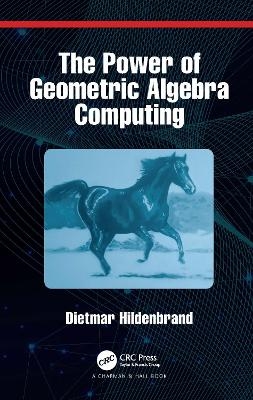
The Power of Geometric Algebra Computing
Chapman & Hall/CRC (Verlag)
978-0-367-68775-5 (ISBN)
Geometric Algebra is a very powerful mathematical system for an easy and intuitive treatment of geometry, but the community working with it is still very small. The main goal of this book is to close this gap from a computing perspective in presenting the power of Geometric Algebra Computing for engineering applications and quantum computing.
The Power of Geometric Algebra Computing is based on GAALOPWeb, a new user-friendly, web-based tool for the generation of optimized code for different programming languages as well as for the visualization of Geometric Algebra algorithms for a wide range of engineering applications.
Key Features:
Introduces a new web-based optimizer for Geometric Algebra algorithms
Supports many programming languages as well as hardware
Covers the advantages of high-dimensional algebras
Includes geometrically intuitive support of quantum computing
This book includes applications from the fields of computer graphics, robotics and quantum computing and will help students, engineers and researchers interested in really computing with Geometric Algebra.
Dietmar Hildenbrand is a lecturer in Geometric Algebra at TU Darmstadt.
Foreword
Preface
Acknowledgements
Introduction
1.1 GEOMETRIC ALGEBRA
1.2 GEOMETRIC ALGEBRA COMPUTING
1.3 OUTLINE
Geometric Algebras for Engineering
2.1 THE BASICS OF GEOMETRIC ALGEBRA
2.2 CONFORMAL GEOMETRIC ALGEBRA (CGA)
2.2.1 Geometric Objects of Conformal Geometric Algebra
2.2.2 Angles and Distances in 3D
2.2.3 3D Transformations
2.3 COMPASS RULER ALGEBRA (CRA)
2.3.1 Geometric objects
2.3.2 Angles and Distances
2.3.3 Transformations
2.4 PROJECTIVE GEOMETRIC ALGEBRA (PGA) WITH GANJA
2.4.1 2D PGA
2.4.2 3D PGA
GAALOP
3.1 INSTALLATION 26
3.2 GAALOPSCRIPT 28
3.2.1 The main notations 28
3.2.2 Macros and Pragmas 28
3.2.3 Bisector Example 29
3.2.4 Line-Sphere Example 30
GAALOPWeb
4.1 THE WEB INTERFACE
4.2 THE WORKFLOW
4.3 GAALOPWEB VISUALIZATIONS
4.3.1 Visualization of the Bisector Example
4.3.2 Visualization of the Rotation of a Circle
4.3.3 Visualization of the Line-Sphere Example
4.3.4 Visualization of a Sphere Of Four Points
4.3.5 Sliders
GAALOPWeb for C/C++
5.1 GAALOPWEB HANDLING
5.2 CODE GENERATION AND RUNTIME PERFORMANCE
BASED ON GAALOPWEB
GAALOPWeb for Python
6.1 THE WEB INTERFACE
6.2 THE PYTHON CONNECTOR FOR GAALOPWEB
6.3 CLIFFORD/PYGANJA
6.4 GAALOPWEB INTEGRATION INTO CLIFFORD/PYGANJA
6.5 USING PYTHON TO GENERATE CODE NOT SUPPORTED BY GAALOPWEB
Molecular Distance Application using GAALOPWeb
for Mathematica
7.1 DISTANCE GEOMETRY EXAMPLE
7.2 GAALOPWEB FOR MATHEMATICA
7.2.1 Mathematica code generation
7.2.2 The Web-Interface
7.3 COMPUTATIONAL RESULTS
Robot Kinematics based on GAALOPWeb for Matlab
8.1 THE MANIPULATOR MODEL
8.2 KINEMATICS OF A SERIAL ROBOT ARM
8.3 MATLAB TOOLBOX IMPLEMENTATION
8.4 THE GAALOP IMPLEMENTATION
8.5 GAALOPWEB FOR MATLAB
8.6 COMPARISON OF RUNTIME PERFORMANCE
The Power of highdimensional Geometric Algebras
9.1 GAALOP DEFINITION
9.2 VISUALIZATION
GAALOPWeb for Conics
10.1 GAALOP DEFINITION
10.1.1 definition.csv
10.1.2 macros.clu
10.2 GAC OBJECTS
10.3 GAC TRANSFORMATIONS
10.4 INTERSECTIONS
Double Conformal Geometric Algebra
11.1 GAALOP DEFINITION OF DCGA
11.2 THE DCGA OBJECTS
11.2.1 Ellipsoid, Toroid and Sphere
11.2.2 Planes and Lines
11.2.3 Cylinders
11.2.4 Cones
11.2.5 Paraboloids
11.2.6 Hyperboloids
11.2.7 Parabolic and Hyperbolic Cylinders
11.2.8 Specific Planes
11.2.9 Cyclides
11.3 THE DCGA TRANSFORMATIONS
11.4 INTERSECTIONS
11.5 REFLECTIONS AND PROJECTIONS
11.6 INVERSIONS
Geometric Algebra for Cubics
12.1 GAALOP DEFINITION
12.2 CUBIC CURVES
GAALOPWeb for GAPP
13.1 THE REFLECTOR EXAMPLE
13.2 THE WEB INTERFACE 1
13.3 GAPP CODE GENERATION
GAALOPWeb for GAPPCO
14.1 GAPPCO IN GENERAL
14.2 GAPPCO I
14.2.1 GAPPCO I architecture
14.2.2 The Compilation Process
14.2.3 Configuration Phase
14.2.4 Runtime Phase
14.3 THE WEB INTERFACE
GAPPCO II
15.1 THE PRINCIPLE
15.2 EXAMPLE
15.3 IMPLEMENTATION ISSUES
Introduction to Quantum Computing
16.1 COMPARING CLASSIC COMPUTERS WITH QUANTUM COMPUTERS
16.2 DESCRIPTION OF QUANTUM BITS
16.3 QUANTUM REGISTER
16.4 COMPUTING STEPS IN QUANTUM COMPUTING
16.4.1 The NOT-operation
16.4.2 The Hadamard transform
16.4.3 The CNOT operation
CHAPTER 17 □ GAALOPWeb as a qubit calculator
17.1 QUBIT ALGEBRA QBA
17.2 GAALOPWEB FOR QUBITS
17.3 THE NOTOPERATION ON A QUBIT
17.4 THE 2QUBIT ALGEBRA QBA2
Appendix
Index
| Erscheinungsdatum | 06.08.2021 |
|---|---|
| Zusatzinfo | 21 Tables, black and white; 90 Line drawings, black and white; 90 Illustrations, black and white |
| Sprache | englisch |
| Maße | 152 x 229 mm |
| Gewicht | 453 g |
| Themenwelt | Mathematik / Informatik ► Informatik ► Grafik / Design |
| Informatik ► Software Entwicklung ► Spieleprogrammierung | |
| Informatik ► Theorie / Studium ► Algorithmen | |
| Informatik ► Theorie / Studium ► Künstliche Intelligenz / Robotik | |
| ISBN-10 | 0-367-68775-5 / 0367687755 |
| ISBN-13 | 978-0-367-68775-5 / 9780367687755 |
| Zustand | Neuware |
| Informationen gemäß Produktsicherheitsverordnung (GPSR) | |
| Haben Sie eine Frage zum Produkt? |
aus dem Bereich


